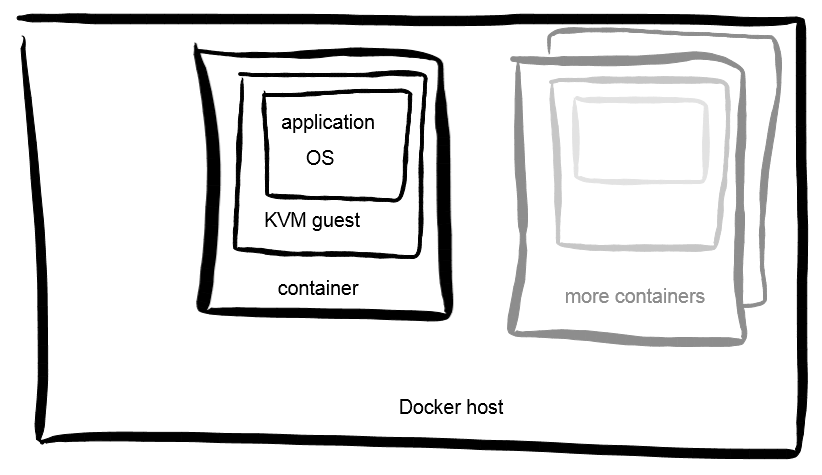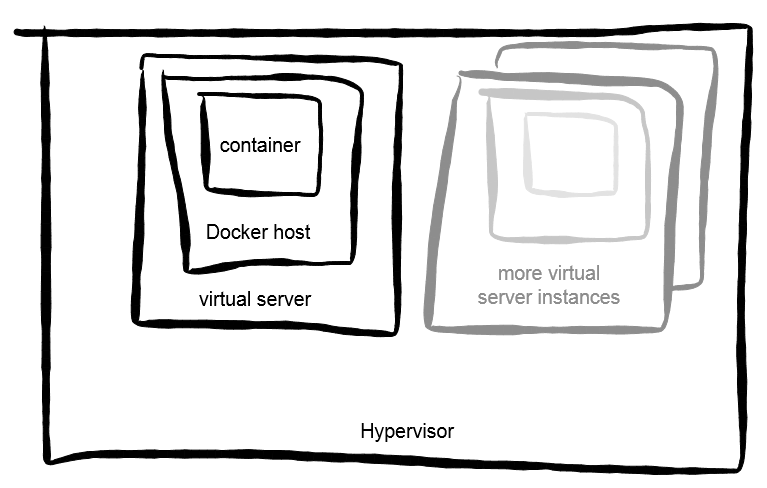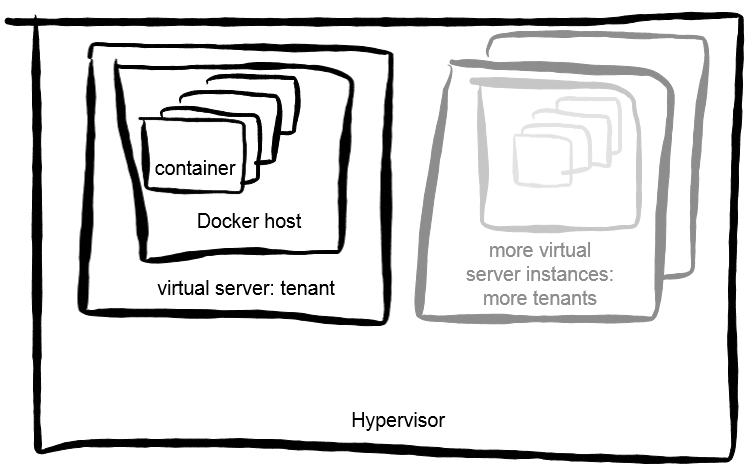virtualization-vs-containerization
http://containerz.blogspot.com/2015/03/virtualization-vs-containerization.html
Virtualization vs. Containerization
With system virtualization, the hypervisor provides a full virtual machine to a guest: the entire OS image including the kernel is now dedicated to the virtual machine. CPU virtualization is used to provide each guest with an exclusive view of a full system environment, and these mechanisms also ensure isolation from other guests. Hypervisor-based management of virtual CPUs, memory and I/O devices is used to define resource consumption of guests.
Which one is better?
As always, it depends on your needs. If you just want to have a number of separate instances to run applications, a container environment often provides greater efficiency, both in managing the application environment, starting the application instances, and in resource consumption. Simple modification and deployment of application environments has been a design principle of container solutions like Docker and is entirely in the DevOps spirit (guess you just have been waiting for more buzzwords).
If you want to have best isolation of environments and come from a server virtualization perspective, then system virtualization may be more relevant: Noisy neighbours are much less of an issue than with containers. While many of the container folks currently focus on improving container isolation, virtual machine isolation is still superior. Coming from physical servers, virtual servers are a natural step, and an existing ecosystem around server management can often be applied to virtual servers, too.
On z systems, Linux has good scalability (to run containers), but z is the platform with an extremely efficient virtualization technology (to run virtual servers), and it is inherent in the entire system architecture. Without having measured it, combining the technologies is probably less painful on z Systems than on other platforms.
There is a third way: both.
Combining system virtualization with containers can be done in multiple ways:
1. A Virtual Machine in a Container

Docker has quite some flexibility on where containers are deployed. One option (called "execution driver") is to use KVM images. This allows to use all the DevOps methods of Docker and combine it with best isolation available, at the cost of having to start up entire Operating System instances when starting containers -- meaning startup time and footprint. Memory efficiencies can only be realized through Kernel Samepage Merging (KSM) -- less effective and efficient, but it's a start.
2. A Container in a Virtual Machine

Conversely, you can run a virtual machine and start a container inside. The VM would not be controlled by Docker, but by existing virtualization management infrastructure. Once the OS instance is up, starting a container would then be done using Docker, and no special setup has to be performed for running containers. Again, containers would have strong isolation since the next container runs in another virtual system; footprint-wise, efficiencies would only be possible through memory deduplication techniques by the hypervisor.
2b. Multiple Containers in a Virtual Machine

This is a variation of running Docker in a VM, suitable for multi-tenancy environments. Here, the assumption is that strongest isolation is only required between containers of different tenants, and straight Linux container isolation is good enough between several containers of the same tenant. Advantages are lower number of virtual machines to run, best isolation between tenants, and enjoying all the efficiencies of vanilla Docker setups.
To summarize: it depends.
virtualization-vs-containerization的更多相关文章
- [WPF]WPF Data Virtualization和UI Virtualization
这篇博客将介绍WPF中的虚拟化技术. 1. Data Virtualization 通常情况下我们说数据虚拟化是指数据源没有完全加载,仅加载当前需要显示的数据呈现给用户.这种场景会让我们想到数据分页显 ...
- Geneve: Generic Network Virtualization Encapsulation
Earlier this year, VMware, Microsoft, Red Hat and Intel published an IETF draft on Generic Network V ...
- [Virtualization][SDN] VXLAN到底是什么 [转]
写在转发之前: 几个月以前,在北大机房和燕园大厦直接拉了一根光钎.两端彼此为校园内公网IP.为了方便连接彼此机房,我做个一个VPN server在燕园的边界,北大机房使用client拨回.两个物理机房 ...
- Virtualization API之libvirt
The virtualization API 之开源 libvirt探究 By Ruiy: libvirt supports Hypervisors(注,相关的hypervisors项目的权威网站已经 ...
- this computer does not support Intel Virtualization Technology (VT-x) .Haxm can'not be installed
this computer does not support Intel Virtualization Technology (VT-x) .Haxm can'not be installed 本机不 ...
- 【转】How to Start Intel Hardware-assisted Virtualization (hypervisor) on Linux to Speed-up Intel Android x86 Emulator
[转]How to Start Intel Hardware-assisted Virtualization (hypervisor) on Linux to Speed-up Intel Andro ...
- Connecting Docker for Cloud Services using SDN and Network Virtualization
Abstract The explosive scale of container CPUs needs highly efficient network virtualization Chal ...
- RH133读书笔记(10)-Lab 10 Exploring Virtualization
Lab 10 Exploring Virtualization Goal: To explore the Xen virtualization environment and the creation ...
- <Mastering KVM Virtualization>:第一章 了解Linux虚拟化
本章为读者提供了Linux虚拟化中流行技术的深刻见解,以及相较于其他同类技术的优势特点.本书共有14章,囊括了KVM虚拟化中的各个方面,从KVM的内部构造开始,并包括了诸如软件定义网络(SDN),性能 ...
随机推荐
- Form - CHECKBOX全选功能
FORM BUILDER开发,遇到这样一个需求: 添加一个CHECKBOX完成全选功能,红框为新添加的CHECKBOX(如图示) Try to use APP_RECORD.FOR_ALL_RECOR ...
- [Hadoop源码解读](三)MapReduce篇之Job类
下面,我们只涉及MapReduce 1,而不涉及YARN. 当我们在写MapReduce程序的时候,通常,在main函数里,我们会像下面这样做.建立一个Job对象,设置它的JobName,然后配置输入 ...
- MySQL配置文件-my.ini
下面允许我介绍一下MySQL的my.ini配置文件: my.ini是什么? my.ini是MySQL数据库中使用的配置文件,修改这个文件可以达到更新配置的目的. my.ini存放在哪里? my.ini ...
- BZOJ_1625_ [Usaco2007_Dec]_宝石手镯_(01背包)
描述 http://www.lydsy.com/JudgeOnline/problem.php?id=1625 01背包裸题. p.s.随便点开一道就是水题... 分析 ... #include &l ...
- weblogic配置数据源出错
Connection test failed. Listener refused the connection with the following error: ORA-12505, TNS:lis ...
- js正则表达式及代码
//校验是否全由数字组成function isDigit(s){var patrn=/^[0-9]{1,20}$/;if (!patrn.exec(s)) return falsereturn tru ...
- 处理Selection对象和Range对象——Word VBA中重要的两个对象
处理Selection对象和Range对象——Word VBA中重要的两个对象 Word 开发人员参考Selection 对象代表窗口或窗格中的当前所选内容.所选内容代表文档中选定(或突出显示)的区域 ...
- iphone4s丢失如何找回
iphone4s丢失如何找回 iphone4s手机丢了怎么办,其实苹果手机自带找回功能,但是前提你得打开了icloud这款软件. 方法/步骤 1 在手机的设置里找到icloud设置,如图. 2 点击进 ...
- Linux中ifreq 结构体分析和使用 及其在项目中的简单应用
[基础知识说明] 结构原型: /* * Interface request structure used for socket * ioctl's. All interface ioctl's mu ...
- apple mac 下使用机械键盘的办法,键盘映射工具软件,apple mac Mechanical keyboard
apple mac 下使用机械键盘的办法,键盘映射工具软件,apple mac Mechanical keyboard 想在苹果电脑 mac 系统下使用 机械键盘,大部分机械键盘不是为mac设计的,所 ...
